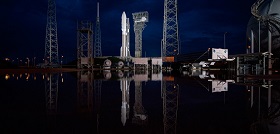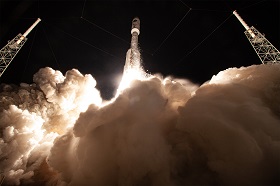As follows from the ASEAN alphabetical order of chairmanship, year 2023 is to be marked with Indonesia taking over the reins. Although it is a bit premature to bet on which priorities will be put in the spotlight, a certain guess can already be made now—which is that the space-related cooperation may come to the fore.
Not digging deeper into the essence of the Indonesian space program, it is worth noting that the country has been setting the tone for regional space activities, having established the first national space agency (LAPAN) among ASEAN in 1963. Obviously, that was a “launch pad” for the further development of the state’s own sounding rockets and a launch site for them (meanwhile, Indonesia is up to developing an equatorial spaceport), a range of multi-purpose satellites, SSA capabilities and even for gaining experience in human space activities (through participation of the national astronauts in ISS missions). According to Euroconsult assessments in 2018 and recent 2020, Indonesia seized regional leadership in terms of government expenditures for space programs (allocating $205 billion and $303 billion respectively).
One of the merits of Indonesia as a spacefaring nation is that it ratified the four core international treaties forming the existing regulatory framework underpinning space activities. However, a truly remarkable thing is not that the state abides by the legal space instruments that were largely drafted by unequivocal space leaders of the 20th century – but rather its burgeoning activity in the international space fora.
Obviously, there are precursors for Indonesia to foster space cooperation in ASEAN on the rights of the Chairman, based both on demand and supply sides. On the one hand, ASEAN as the center of the Asia-Pacific economic and security architecture still lacks leverages and a streamlined strategy of utilizing space technology to a full extent, for the benefit of political-security, economic and socio-cultural communities. On the other hand, if the momentum continues, Indonesia will likely amplify the country’s ongoing space-related endeavors with a view to enhance its political and economic position in the region.
As a result, we may anticipate respective advancements in the ASEAN agenda. Among potential deliverables could not only be operationalization of commitments under the ASEAN Plan of Action on Science, Technology and Innovation especially regarding the transfer of space technology and its applications. It could also have to do with exploring new avenues of cooperation to cover opportunities for greater integration of ASEAN into global space economy ecosystem, including with the means of public-private/academia/NGO partnerships, or matters of keeping space environment peaceful, safe and stable with the focus on potential techniques of space traffic management and space debris removal. From the political angle, the Association will definitely benefit from establishing intra-regional channels of exchanging approaches towards preventing arms race in outer space, building confidence among its members, while strengthening the ASEAN voice in the international fora.
As follows from the ASEAN alphabetical order of chairmanship, year 2023 is to be marked with Indonesia taking over the reins. Although it is a bit premature to bet on which priorities will be put in the spotlight, a certain guess can already be made now—which is that the space-related cooperation may come to the fore.
Current state of affairs in ASEAN
Given the extremely diverse levels of space industries in the region, it comes as no surprise that there are no space issues high on the Association’s agenda. Not only space expenditures and space infrastructure preparedness vary from country to country but there are still members that have no assigned specialized agencies to deal with space matters. Similarly, the region presents a patchwork of regulatory environments, with no unanimity in terms of whether a bunch of international agreements comprising the outer space law are accepted.
Even though, it may hardly be argued that space applications matter for all the Southeast Asian economies, with the potential benefits extending to each and every domain of economic, political and social life. Positive peaceful spillover effects of space applications have, in fact, been recognized at the dawn of the space age—despite the tense geopolitical context of the Cold War. Just recently, the international community once again recognized space was essentially important as a driver of sustainable development, having elaborated the Space 2030 Agenda and its implementation plan.
One illustration to the fact that the Association is well aware of the potential fruits it may reap from space activities is the institutional upgrade that took place back in 1993. At that time, the Sub-Committee on Science and Technology Infrastructure and Resource Development (SCIRD) gave life to the ASEAN Expert Group on Remote Sensing (AEGRS) – to be then transformed into a full-fledged Subcommittee on Space Technology and Applications (SCOSA) in 1997. Both intra-ASEAN projects within SCOSA as well as those conducted with Dialogue Partners have primarily been focusing on capacity-building in receiving and processing remote sensing data as well as exchanging knowledge on potential operationalization of satellite technologies for sustainable development in the region.
To ensure the region has high quality personnel to deal with the issues of space technology and geo-informatics applications in a well-grounded manner, ASEAN has recently undertaken another organizational change. By endorsing the launch of ASEAN Research and Training Centre for Space Technology and Applications (ARTSA) in 2019, it enabled Southeast Asian government agencies, private sector and academia to deepen their knowledge in methods and prospects of leveraging space assets for the sake of increasing regional competitiveness and prosperity. Even more, the initiative will help ASEAN build partnerships with the international organizations (APSCO, JAXA, NASA, ESCAP and UNITAR are already “in”) to unveil the potential of outer space in responding to global challenges, including climate change and other environmental hazards.
Based on the ASEAN Plan of Action on Science, Technology and Innovation 2016-2025 (the key document of ASEAN in terms of orchestrating future SCOSA and consequently ARTSA activities) the Association is currently on the middle of its path towards enhancing the capacity in three priority areas. In particular, these are geoinformatics (e.g. remote sensing, GNSS, GIS), space technology applications (e.g. disaster risk reduction, environment and resource monitoring, communication) and satellites (e.g. nano, micro and small satellites, etc.). In addition, in accordance with the Plan of Action, ASEAN should by far have progressed with such a new area of cooperation as “facilitating and accelerating the transfer of space technology and its applications to the ASEAN region”.
Nonetheless, while ASEAN has managed to gather an extensive network of space technology and application as a result of institutional advancements, the Association seems to be lagging behind the set objectives, currently operating only 33 satellites orbiting the Earth (cumulative figure for the region, compared to the total of 4084, as of May 1, 2021). Meanwhile, none of these have been launched on a nationally developed carrier rocket – which, coupled with remaining gaps regarding ground facilities and lacking space infrastructure, revert us to the issue of space issues grabbing a back seat in the regional STI agenda. Not to mention the absence of clearly articulated space issues in the strategic documents defining the ASEAN economic and political development tracks (to name a few, ASEAN Economic Community and Political-Security Community Blueprints 2025, Master Plan on ASEAN Connectivity 2025).
Altogether, this brings us to an assumption that the Association is gearing up for a greater engagement in space activities and requires a certain level of leadership from inside to intertwine space-based capabilities with regional growth trajectories in a more active fashion.
Role to be assumed by Indonesia
Not digging deeper into the essence of the Indonesian space program, it is worth noting that the country has been setting the tone for regional space activities, having established the first national space agency (LAPAN) among ASEAN in 1963. Obviously, that was a “launch pad” for the further development of the state’s own sounding rockets and a launch site for them (meanwhile, Indonesia is up to developing an equatorial spaceport), a range of multi-purpose satellites, SSA capabilities and even for gaining experience in human space activities (through participation of the national astronauts in ISS missions). According to Euroconsult assessments in 2018 and recent 2020, Indonesia seized regional leadership in terms of government expenditures for space programs (allocating $205 billion and $303 billion respectively).
One of the merits of Indonesia as a spacefaring nation is that it ratified the four core international treaties forming the existing regulatory framework underpinning space activities (leaving the ambiguous 1979 Moon Agreement aside). This is a positive sign, ensuring predictability of the country’s actions in a highly contested and congested environment (of course, to the extent provided by the international space law as such). However, a truly remarkable thing is not that the state abides by the legal space instruments that were largely drafted by unequivocal space leaders of the 20th century – but rather its burgeoning activity in the international space fora.
Here are some arguments in favor. First, quite illustrative are the annual meetings of the UN COPUOS and its Subcommittees giving us a flavor of the matters that concern the international community and, more importantly, the posture of states in this regard. Just a glimpse at the statements made by the Parties in 2021 shows that Indonesia has its say on almost all the items of the agenda, which is rather atypical of its ASEAN neighbors. For instance, in the framework of 64th COPUOS session (25 August-3 September 2021), the country shared its perspective on a broad range of issues from the interrelation of space-based technology and implementation of 2030 Agenda for Sustainable Development, including combating climate change and its impacts, to organizational matters. At the same time, other ASEAN members preferred to partake in a more general exchange of views.
Second, last year was marked with the adoption of the General Assembly Resolution 75/36 “Reducing space threats through norms, rules and principles of responsible behaviors” that came as a UK-initiated response to the urgent need to ensure outer space is a peaceful, safe, stable, secure and sustainable environment. One of the provisions of the Resolution encouraged states to “study existing and potential threats and security risks to space systems…, characterize actions and activities that could be considered responsible, irresponsible or threatening…, share their ideas on the further development and implementation of norms, rules and principles of responsible behaviors”. Hardly could a better moment for contributing to the space-related norms-/rules-making be imagined—a summary report of responses will be conveyed to the General Assembly (at its 76th session) for the further discussion by Member States. In this context Indonesia’s submitted response (the only one from ASEAN), with all those strong references to the remaining objective of formulating a legally binding instrument on preventing arms race in outer space (PAROS) to be supported by confidence building measures, leads us to further deliberations on the role the country wishes to play in the Space Race 2.0.
Another argument to suggest that Indonesia is increasing its engagement in global space affairs is that apart from actively participating in the Space Economy Leaders Meetings—a novel format brought about in G20 by Saudi Arabia and then successively inherited by Italy—the country has already announced the third edition of the event to be held in 2022. Indonesia’s willingness to host the meeting on the margins of its Presidency in the Grouping comes as no surprise, indeed, with space economy projected to generate revenue of more than $1 trillion in 2040 along with numerous socio-economic spin-offs.
Way forward
Obviously, there are precursors for Indonesia to foster space cooperation in ASEAN on the rights of the Chairman, based both on demand and supply sides. On the one hand, ASEAN as the center of the Asia-Pacific economic and security architecture still lacks leverages and a streamlined strategy of utilizing space technology to a full extent, for the benefit of political-security, economic and socio-cultural communities. On the other hand, if the momentum continues, Indonesia will likely amplify the country’s ongoing space-related endeavors with a view to enhance its political and economic position in the region.
As a result, we may anticipate respective advancements in the ASEAN agenda. Among potential deliverables could not only be operationalization of commitments under the ASEAN Plan of Action on Science, Technology and Innovation especially regarding the transfer of space technology and its applications. It could also have to do with exploring new avenues of cooperation to cover opportunities for greater integration of ASEAN into global space economy ecosystem, including with the means of public-private/academia/NGO partnerships, or matters of keeping space environment peaceful, safe and stable with the focus on potential techniques of space traffic management and space debris removal. Another promising area of mutual interest could be monitoring GHG emissions from satellites that will be crucial for the ASEAN members to achieve their climate goals, recently reaffirmed and leveled up in Glasgow. From the political angle, the Association will definitely benefit from establishing intra-regional channels of exchanging approaches towards preventing arms race in outer space, building confidence among its members, while strengthening the ASEAN voice in the international fora.








